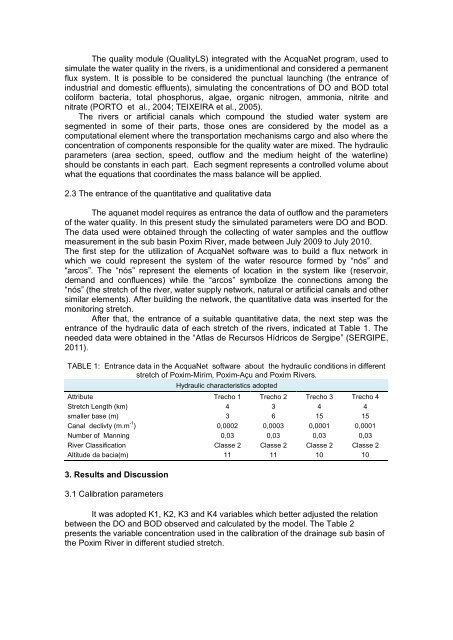poster - International Conference of Agricultural Engineering
poster - International Conference of Agricultural Engineering
poster - International Conference of Agricultural Engineering
You also want an ePaper? Increase the reach of your titles
YUMPU automatically turns print PDFs into web optimized ePapers that Google loves.
The quality module (QualityLS) integrated with the AcquaNet program, used to<br />
simulate the water quality in the rivers, is a unidimentional and considered a permanent<br />
flux system. It is possible to be considered the punctual launching (the entrance <strong>of</strong><br />
industrial and domestic effluents), simulating the concentrations <strong>of</strong> DO and BOD total<br />
coliform bacteria, total phosphorus, algae, organic nitrogen, ammonia, nitrite and<br />
nitrate (PORTO et al., 2004; TEIXEIRA et al., 2005).<br />
The rivers or artificial canals which compound the studied water system are<br />
segmented in some <strong>of</strong> their parts, those ones are considered by the model as a<br />
computational element where the transportation mechanisms cargo and also where the<br />
concentration <strong>of</strong> components responsible for the quality water are mixed. The hydraulic<br />
parameters (area section, speed, outflow and the medium height <strong>of</strong> the waterline)<br />
should be constants in each part. Each segment represents a controlled volume about<br />
what the equations that coordinates the mass balance will be applied.<br />
2.3 The entrance <strong>of</strong> the quantitative and qualitative data<br />
The aquanet model requires as entrance the data <strong>of</strong> outflow and the parameters<br />
<strong>of</strong> the water quality. In this present study the simulated parameters were DO and BOD.<br />
The data used were obtained through the collecting <strong>of</strong> water samples and the outflow<br />
measurement in the sub basin Poxim River, made between July 2009 to July 2010.<br />
The first step for the utilization <strong>of</strong> AcquaNet s<strong>of</strong>tware was to build a flux network in<br />
which we could represent the system <strong>of</strong> the water resource formed by “nós” and<br />
“arcos”. The “nós” represent the elements <strong>of</strong> location in the system like (reservoir,<br />
demand and confluences) while the “arcos” symbolize the connections among the<br />
“nós” (the stretch <strong>of</strong> the river, water supply network, natural or artificial canals and other<br />
similar elements). After building the network, the quantitative data was inserted for the<br />
monitoring stretch.<br />
After that, the entrance <strong>of</strong> a suitable quantitative data, the next step was the<br />
entrance <strong>of</strong> the hydraulic data <strong>of</strong> each stretch <strong>of</strong> the rivers, indicated at Table 1. The<br />
needed data were obtained in the “Atlas de Recursos Hídricos de Sergipe” (SERGIPE,<br />
2011).<br />
TABLE 1: Entrance data in the AcquaNet s<strong>of</strong>tware about the hydraulic conditions in different<br />
stretch <strong>of</strong> Poxim-Mirim, Poxim-Açu and Poxim Rivers.<br />
Hydraulic characteristics adopted<br />
Attribute Trecho 1 Trecho 2 Trecho 3 Trecho 4<br />
Stretch Length (km) 4 3 4 4<br />
smaller base (m) 3 6 15 15<br />
Canal declivty (m.m -1 ) 0,0002 0,0003 0,0001 0,0001<br />
Number <strong>of</strong> Manning 0,03 0,03 0,03 0,03<br />
River Classification Classe 2 Classe 2 Classe 2 Classe 2<br />
Altitude da bacia(m) 11 11 10 10<br />
3. Results and Discussion<br />
3.1 Calibration parameters<br />
It was adopted K1, K2, K3 and K4 variables which better adjusted the relation<br />
between the DO and BOD observed and calculated by the model. The Table 2<br />
presents the variable concentration used in the calibration <strong>of</strong> the drainage sub basin <strong>of</strong><br />
the Poxim River in different studied stretch.

















